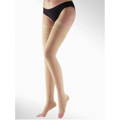Compression Stockings: Do you know what "Compression Type" is?
AUTHOR
Edward C
CATEGORY
Key Facts
PUBLISHED
May 21, 2023
REVISED
March 18, 2025

TABLE OF CONTENTS
- What the Compression Levels Mean
- Medical Grade Class 1 – 14 – 18 mmHg
- Medical Grade Class 2 – 18 – 24 mmHg
- Medical Grade Class 3 – 25 – 35 mmHg
- Consult a Specialist or Doctor
Introduction
One of the confusing aspects of choosing the right compression stocking is to understand the level of compression. Compression stockings have a range of numbers to indicate how much graduated compression the garment has. The standard compression levels for compression stockings are 15-20 mmHg (over the counter), 14 – 18 mmHg (medical class 1), 18 – 24 mmHg (medical class 2) and 25 – 35 mmHg (medical class 3). There are other levels of compression, however these are standardised and the most commonly used.
Scintera carries a range of the highest quality Maxis (German) Medical Compression Stockings with Maxis Micro Compression Stockings and Maxis Relax Stockings.
For those in a hurray here's a great summary:
Compression Class 1 stockings provide a level of compression at the ankle of 14 – 18 millimetres of mercury (mmHg). They are most often used for smaller problems like swollen feet, tired legs and small varicose veins.
Compression Class 2 stockings provide a level of compression at the ankle of 18 – 24 mmHg. They are prescribed by doctors for bigger problems such as venous insufficiency and more serious varicose veins. They are also used after vein surgery or other operations on the lower leg. It is not advisable to use compression class 2 stockings without consulting a doctor or nurse.
1. What the Compression Levels Mean
Compression levels are indicated with a range of numbers like “20-30 mmHg”, which means that the amount of compression will not fall below 20 mmHg and not exceed 30 mmHg. The unit of measurement is called “millimeters of mercury” which is a measurement of pressure, also used in blood pressure. Another important detail about Maxis Micro compression stockings is that they graduate the compression in their compression stockings and socks. Having “graduated compression” means that the compression is strongest at the ankle and gets lighter as you go up the leg. This very special way of knitting a compression stocking allows circulation to improve up and out of the legs. (There would be devastating effects if the graduated compression went down towards your feet instead of going away from your feet.)
2. Medical Grade Class I: 14 – 18 mmHg
The 14–18 mmHg level of compression is the first medical grade compression. It’s the most widely used medical grade because it provides competent compression to your legs without being too strong. The 14 – 18 mmHg level of compression is great for managing swelling in your legs, spider veins, varicose veins, travel, sports and after certain surgeries. Pregnant mothers are also finding the benefits of compression stockings and are starting to wear 14 – 18 mmHg to alleviate heaviness, swelling and aching in their legs. The 14 – 18 mmHg level of compression is available in a wide variety of styles for both men and women in knee high, thigh high, and pantyhose styles.
3. Medical Grade Class II 18 – 24 mmHg
The 18 – 24 mmHg level of compression is a stronger medical grade class II. It’s recommended for leg health symptoms that range from moderate to severe. The 18 – 24 mmHg level of compression is also recommended when you have a blood clot or a deep vein thrombosis DVT. Patients with lymphedema are also recommended to use the 18 – 24 mmHg level of compression. When choosing the 18 – 24 mmHg compression, also be sure to think about what kind of fabric your compression stocking or sock should be. Because the stocking is providing more compression in the 18 – 24 mmHg strength, it’s a good idea to choose a more durable material.
4. Medical Grade Class III 25 – 35 mmHg
The 25 – 35 mmHg level of compression is a very strong compression. It’s strongly recommend that people considering this level of compression have thoroughly consulted their doctor or healthcare professional about compression stockings and their health. This level of compression is used for severe venous stasis, wound management, and lymphedema.
5. Consult a Specialist or Doctor
When choosing a compression level for your compression stockings, you’ll likely want to consult your doctor for recommendations. Depending on your situation, a lighter compression level may be more effective for you than a stronger level of compression.
Also, remember to replace your compression stockings every five or six months in order to assure that they maintain their proper shape and compression level. If your compression stockings start to feel loose, it’s time for a new pair.
Thanks for reading and if you have more questions about levels of compression for stockings, contact the Scintera Customer Care Team at any time!

